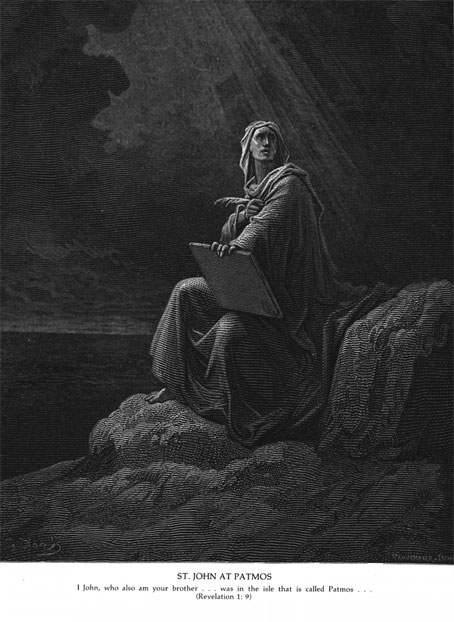Apr
11
2009

There are conflicting traditions concerning John. A widely held opinion is that he was banished to Patmos by the Emperor Domitian who reigned from AD 81 through 96. If so, this makes preterism a paper tiger.
Continue reading
Comments Off | tags: Bible history, Church History, David Chilton, Ezekiel, John, Kenneth Gentry, Literary Structure, Preterism | posted in The Last Days
Apr
10
2009
 or ‘How to Raise Monsters’
or ‘How to Raise Monsters’
Peter Leithart points out that the very early verses in John’s gospel can be corresponded with the Creation week:
DAY 1: The Light of the World (1:1-18)
DAY 2: The Baptism of John (1:19-28)
DAY 3: Jesus’ Baptism (1:29-34): dry land emerges from water, “the next day.”
DAY 4: John Points Disciples to Jesus (1:35-39)
DAY 5: Disciples Bring Brothers (1:40-42)
DAY 6: Jesus and Nathanael (1:43-51): “the following day,” the first day
DAY 7: [nothing]: Sabbath; the second day
DAY 8: The Wedding at Cana (2:1-11): “the third day”
More detail here.
It seems to be the case with many Bible books that they start off with a small seven, which is part of a larger one, which is then part of a great seven that structures the book (among other internal structures).
As with Matthew’s gospel, the next level in John covers the first few chapters, and might even solve a textual difficulty:
Continue reading
Comments Off | tags: Creation Week, Daniel, John, Peter Leithart, Priesthood, Typology | posted in Biblical Theology
Apr
8
2009
“It is surely a remarkable incident, if it is not the Providence of God, that these human, un-selfconscious letters of the very early days of Christianity should have been preserved. What is even more remarkable is their astonishing relevance today. It seems that the men who wrote these letters concentrated upon the essential spiritual core of human life. They provide that spiritual vitamin, without which human life is at best sickly, and at worst dead. While scarcely touching on any “modern problem” they yet manage to give pointers of principle which show the way, and the spirit, in which the problems of even a highly complex age such as ours may be tackled successfully.
The present translator who has closely studied these letters for several years is struck by two things. First, their surprising vitality. He is continually struck by the living quality of the material on which he is working. Some will, no doubt, consider it merely superstitious reverence for “Holy Writ”, yet again and again the writer felt rather like an electrician re-wiring an ancient house without being able to “turn the mains off”.
From the Translator’s Preface to Letters to Young Churches (The New Testament Epistles) by J. B. Phillips
Read Translators’ Impressions:
http://www.bullartistry.com.au/pdf_bestill/037BeStill.pdf
Comments Off | tags: John, Revelation | posted in Biblical Theology
Apr
8
2009
“…when one is confronted with the language of Revelation it is no mere difference of style which makes one gasp, but crudities, grammatical errors and a quite extraordinary juxtaposition of words. So wholly different is the book in its word-usage and composition from the Fourth Gospel that many scholars find themselves unable to believe that both could be written by the same person. The Fourth Gospel is written, within its limited vocabulary, smoothly and correctly and would probably have caused no literary qualms in a contemporary Greek reader. But Revelation piles word upon word remorselessly, mixes cases and tenses without apparent scruple, and shows at times a complete disregard for normal syntax and grammar… Continue reading
Comments Off | tags: Apocalyptic, John, Revelation | posted in The Last Days



























